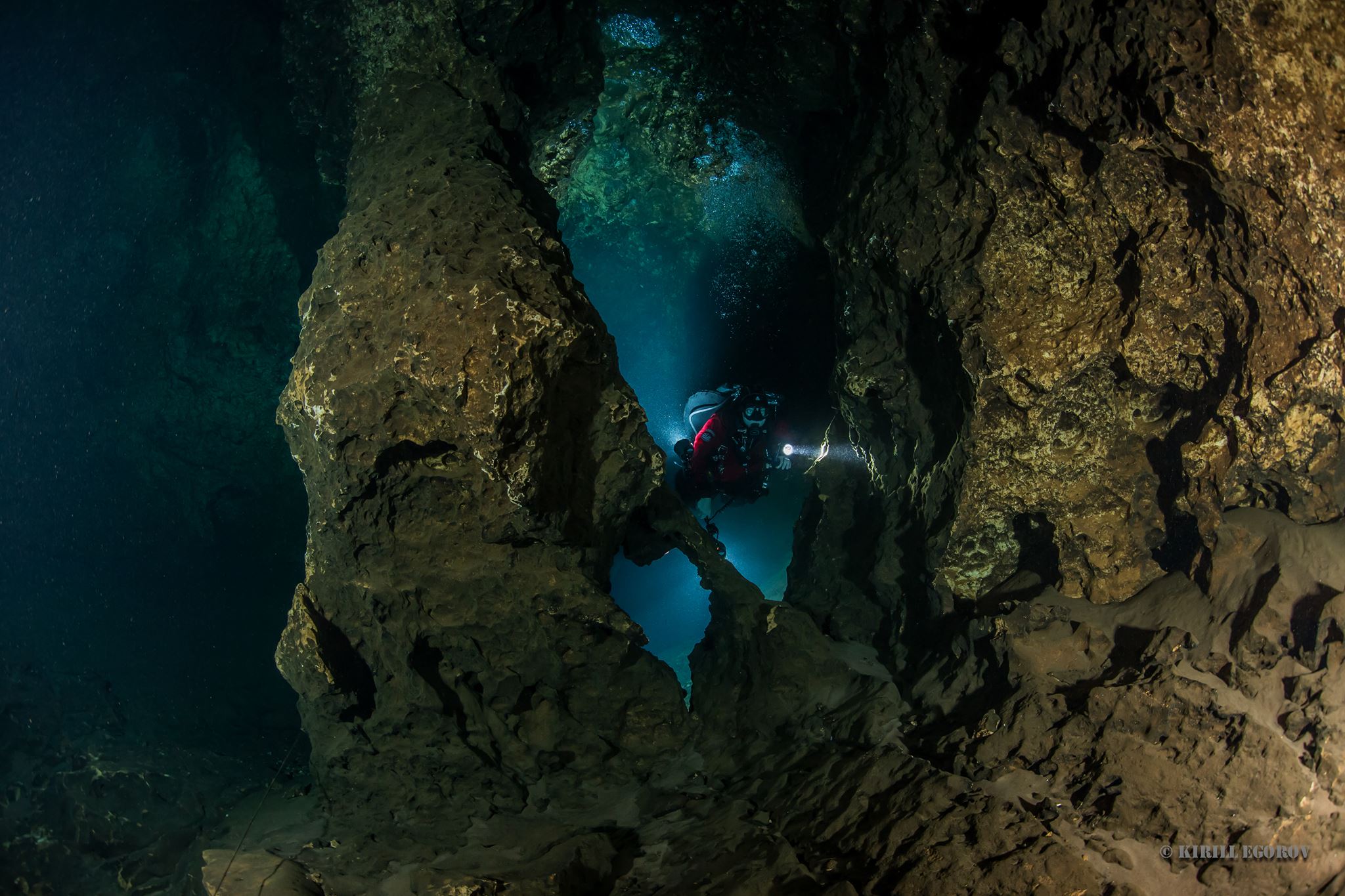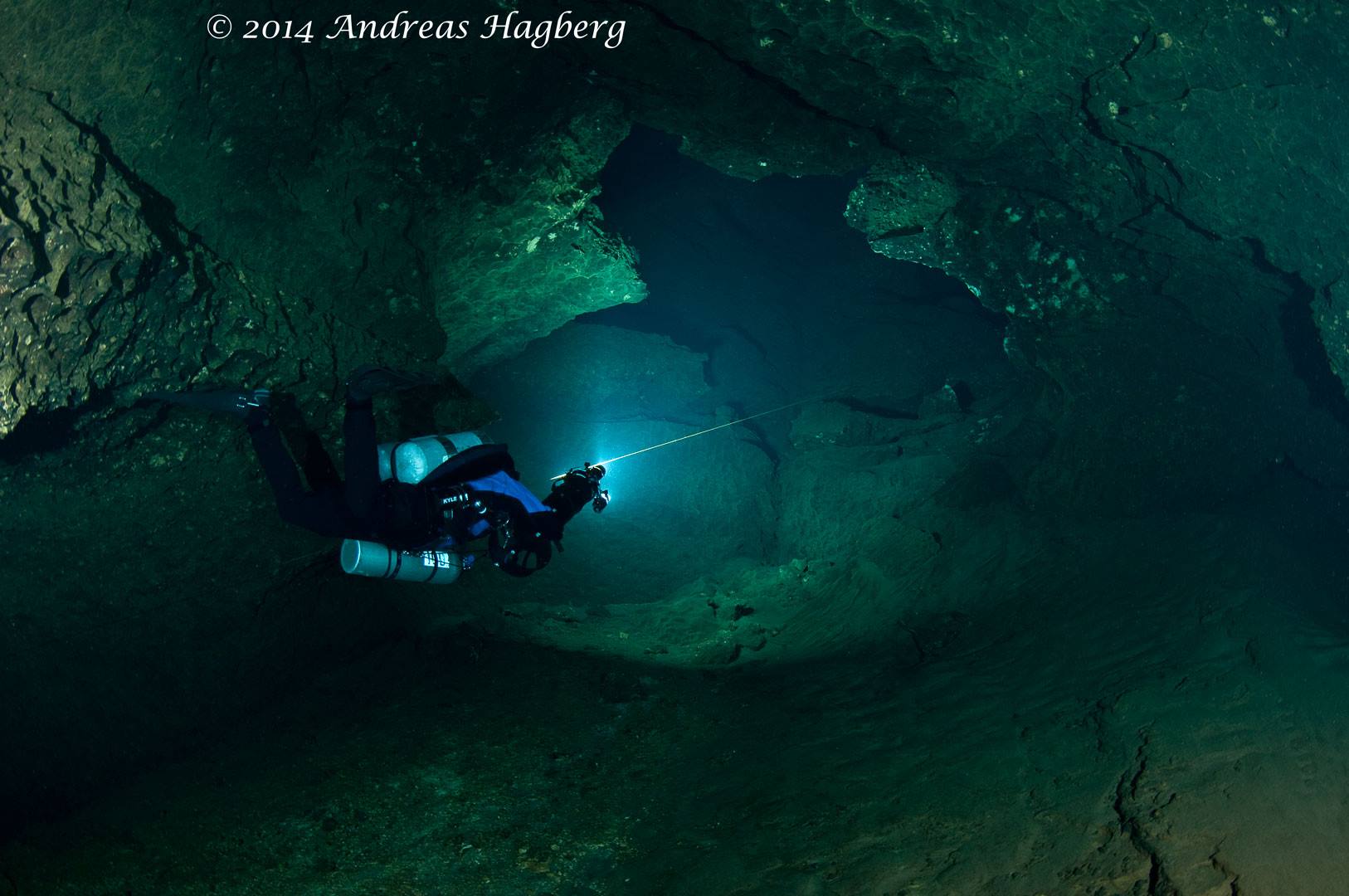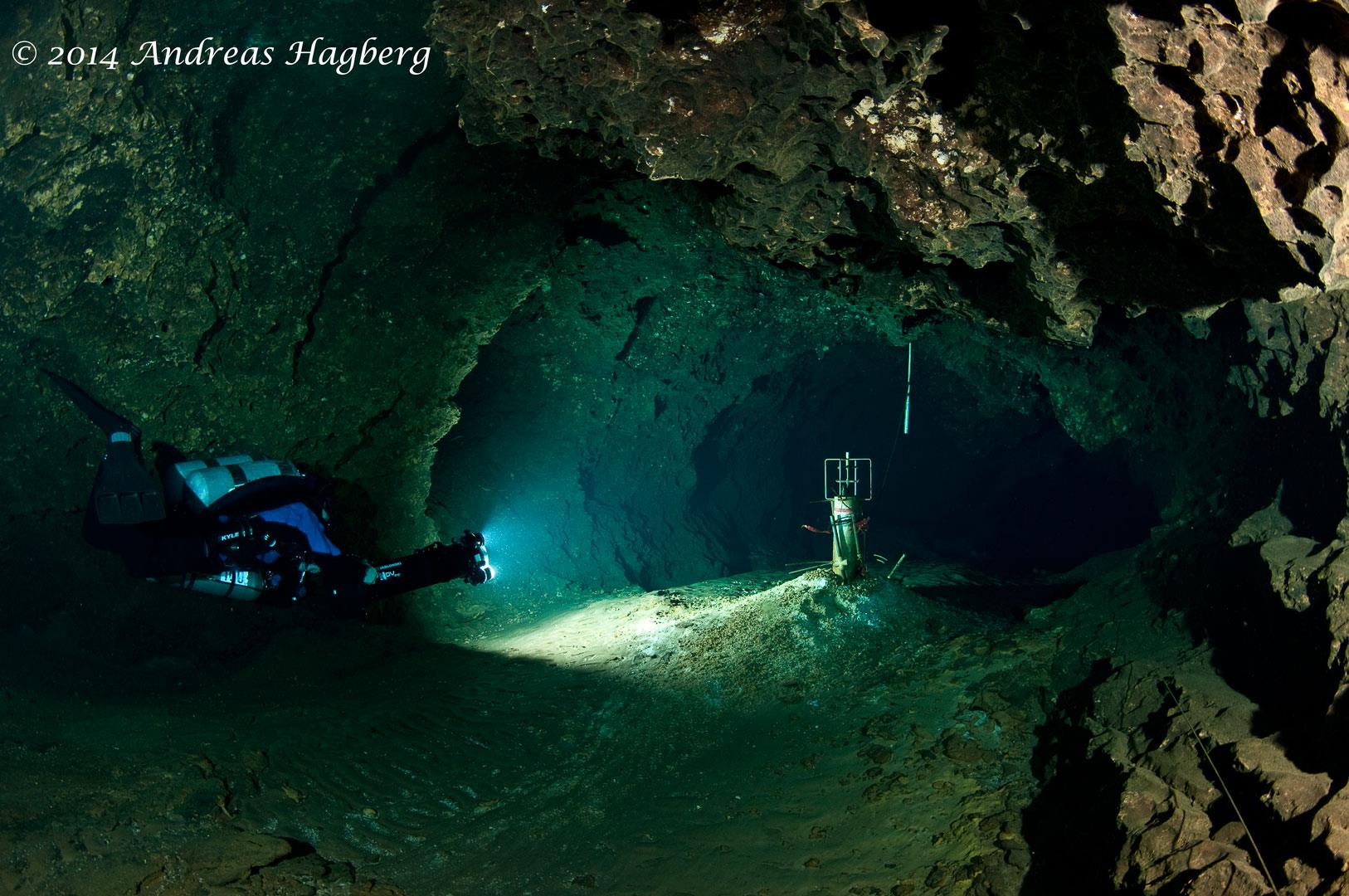Location
Manatee Springs State Park is located roughly six miles WNW of Chiefland, FL. Manatee Springs is located on the Manatee Springs Quadrangle in SW 1/4, SE 1/4, sec. 26, T. 11 S., R. 14 E. All five karst openings (four of which are passable to cave divers) occur along a fracture zone trending in a SW direction approximately 1800' from Manatee Springs to Friedman's Sink.
The park allows swimming, snorkeling, and openwater diving in the main spring run and in Catfish Hotel Sink. Certified cave divers may explore the system from the head spring, Catfish Hotel, or Friedman's Sink. The park system reserves the right to limit the number of divers allowed in the system.
Cave System Access
Several karst windows offer access to the Manatee cave system. Most divers enter the system from Catfish Hotel, which is both near the parking lot and picnic tables. Access through Friedman's involves a quarter mile treck through the woods.
Manatee Springs is known for very high flow and not-so-great visibility. Flow remained high throughout the floods of the spring of 1998.
General Information
Manatee Springs is part of the Florida State Parks system. The park is open 8:00am until sundown 365 days a year. The entrance fee is $6.00 per vehicle and diving is permitted at no additional cost. Lights are allowed for certified cavern and cave divers only. Cave diving and DPV use are allowed with proper credentials; all divers are required to register with the office prior to diving and your certification card will be retained until exit. All divers must be registered by 3:00 p.m. and out of the water and checked out (c-cards returned) by 5:00 p.m.
Once known as the longest cave in the world, the Manatee Springs cave system is one of the most extensive caves in the Suwanee region, with over 20,000' of explored and mapped cave.
The are four unique entrances to the Manatee Springs system, however only two are readily accessible to divers, with a third restricted to divers possessing full cave diver certification.
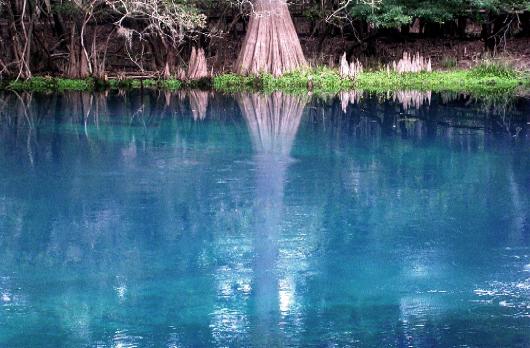
Headspring
The headspring at Manatee reaches a maximum depth of about 30fsw (9msw). Due to the amount of flow produced by the entrance to the cave, most divers choose to avoid entering the cave system from the headspring. However, enjoyable snorkeling and openwater scuba diving activities can be had at the headspring. Freshwater flounder, crappies (red bellies), catfish, and turtles are often found in the run generated from the headspring.
During the winter months, when the oceans get cold, Manatees (sea cows) often migrate up into the headsprings. When Manatees are in the park, divers are not permitted in the headspring. Manatees are an endangered species and should be treated with the utmost respect.
Catfish Hotel
Directly across from the headsprings is the Catfish Hotel sinkhole. Catfish is recognized by usually being covered by a green moss-like plant known as "duckweed." Openwater divers (and openwater dive classes) quite often enjoy diving in Catfish hotel, the visibility can be quite good, and being a slightly offset sink, there is negligible flow in the openwater portion. However, due to the silt and sedimentation on the bottom of the sinkhole, divers should exercise extreme care to avoid disrupting the visibility in the openwater portion.
Cavern divers can find a large cavern area, with depths extending to about 70' within the daylight zone. Fossils of ancient marine animals can be found all over the cavern ceiling and walls. The left side of the cavern heads "downstream" towards Manatee springs. A very popular 500' traverse from Catfish to Manatee is possible, but due to the fact that this is a siphon, should only be performed by divers holding "full cave diver" certification (or equivalent).
The right side of the cavern leads to the upstream portion of Manatee springs. The permanent line starts just outside of the daylight zone, and a reel should always be run to the permanent line.
Heading upstream from Catfish Hotel, divers will encounter a wide passageway with depths of around 100fsw (30msw). Due the dark walls in Manatee, and heavy particulate found in the system, visibility is usually not considered very good, and with the width of the passage often exceeding 50', it is not uncommon to not be able to see the far walls.
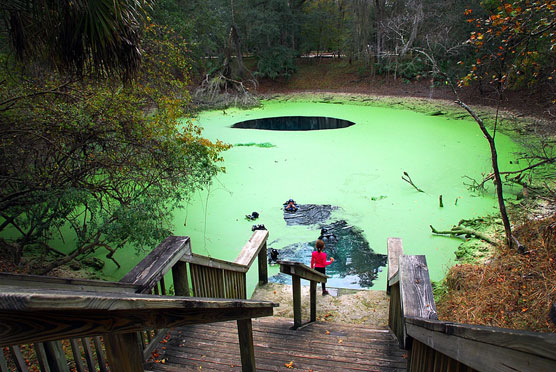
Duckweed at Catfish
Sue Sink
About 900' upstream from Catfish Hotel is Sue Sink. Divers are not permitted to enter or exit at Sue Sink, however there is a 'T' which will allow divers to surface at Sue and take a look around. Sue sink is filled with several Lilly pads, and is in the middle of the campground, so it makes a pretty scene to surface and look around.
Friedman's Sink
About 1000' past Sue Sink is Friedman's Sink. Friedman's was named by Sheck Exley for the early cave explorer Bob Friedman. Access to Friedman's is restricted to full cave divers only, and at least one person in a dive team is required to have been to Friedman's before. You must also specify to the park rangers at check-in time that you will be diving Friedman's: the number of dive teams at Friedman's is limited to two.
The entrance at Friedman's is very tight and restrictive from a depth of around 7' down to 18', as a result performing a 10fsw (3msw) decompression stop in Friedman's with more then two divers can prove interesting.
Diving downstream from Friedman's, divers will find the Sewer Tunnel on the left hand side. The Sewer Tunnel is named for the amount of bacteria that flows out, quite often leaving divers with visibility less then 20'. There is also a circuit that can be done from the Sewer Tunnel to about 500' upstream Friedman's. Like any other circuit, divers should verify the way by diving both sides before completing the circuit.
There is also a popular traverse which can be performed going from Friedman's Sink to Catfish Hotel (and ultimately to Manatee Springs). Divers should first try to swim upstream from Catfish Hotel to verify the traverse and allow proper planning. Staging cars, one at the Friedman's parking lot, and one at the Catfish/Manatee parking is also helpful when performing the traverse.
Heading upstream from Friedman's, the main line continues on to a distance of about 7500' from Friedman's where the original exploration was conducted by Sheck Exley in the 1980's. Due to the very extreme distance from the nearest exit, this should be considered a very advanced cave dive.
Upstream from Friedman's there are a few different tunnels that divers can explore. About 1300' upstream is a tunnel named the "Milk Tunnel" due the "milky" quality of the water. Around 2000' divers can explore a siphon tunnel which contains a large amount of fossilized animal bones.
Near the 2500' distance is the "Blue Spring Tunnel," which due to a lack of survey data, does not sit on any map. The water in this tunnel comes from a thermal vent, is always crystal clear, and is a few degrees warmer then the rest of the cave system. There are geothermal vents that can be seen in the "Blue Spring Tunnel," where haloclines due to the differing water temperature can be observed.
The last two tunnels of interest are the Kincaid Siphon Tunnel and the McKinlay Spring Tunnel which start beyond 6000' of penetration from Friedman's. Both of these tunnels have been explored out in excess of 10,000' from the nearest exit, but due to the logistics involved in performing dives in these tunnels, they should be considered extreme advanced cave dives.
Logistics of Diving at Manatee Springs
The water temperature at Manatee Springs is a constant 71F except in the few locations where geothermal vents exist. The average depth is about 90fsw (27msw), with a maximum depth of about 110fsw (33msw). For divers using EAN, 30% nitrox is the preferred dive gas for all dives shorter then 120 minutes.
Several sections of the Manatee Springs cave system get very shallow; as shallow as 20' in some sections several thousand feet from the nearest exit! Divers with chronic problems equalizing their ears should be extra careful while diving here.
The cave system has several fossilized remains in it. It is not uncommon to find large bones of some ancient animal. Divers should remember the motto "take nothing but memories, leave nothing but bubbles" and leave the fossils for others to enjoy.
When most people think of Manatee Springs they think of high flow and poor visibility. Being a first magnitude spring, the flow at Manatee can be quite formidable. Due to the high concentration of an iron oxide bacteria (an orange colored bacteria that can best be described as mucous), visibility is often reduced by a diver's exhaust bubbles.
However, every few years during a period of great flood, the flow in Manatee drops and the visibility has been known to exceed 150' during these periods. Indeed, if you are lucky enough to dive during one of these periods you will be in for a splendid treat!
Hazardous Life
Being in an outdoor park, Manatee is host to many of the hazardous life you could expect to find. Rattlesnakes have been spotted on the trail leading to Friedman's, wild boars have been trapped in the surrounding woods, and alligators have been spotted in the main spring. Like all wild animals, treating these hazards with proper respect, will cause them to leave you alone.
Deer ticks and Lone Star ticks, on the other hand, are quite plentiful at Manatee Springs. Both types of ticks are potential carriers for Lyme Disease, a debilitating neurological disorder. Although Lyme Disease specifically caused by ticks from Manatee Springs park has never been proven, the prudent diver would bring an appropriate bug repellent to ward off ticks.
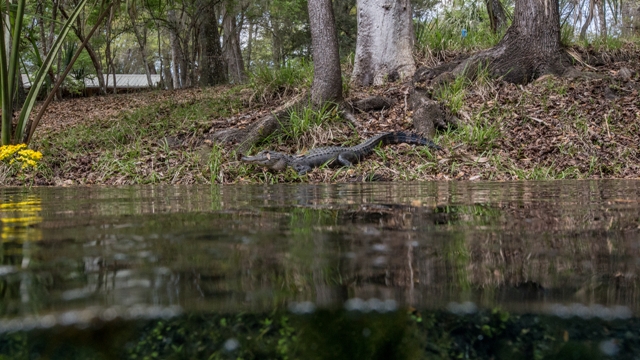
Support Facilities
There are restrooms and showers in the parking area by the headspring. There is also a concession stand which is open during the summer months. A pay phone, water fountain, and soda machine are located in the pavilion by the concession stand.
Six miles from Manatee Springs is the town of Chiefland. Restaurants and shops are available there. In the past, air fills were also available, but currently there is no dive shop closer than High Springs. Extreme Exposure opens at 8:00am daily and offers rental gear as well as tank fills.
The nearest available hyperbaric chamber is typically in Talahassee, FL. This does change periodically and calling DAN (Divers Alert Network) for guidance is advised. Shands hospital in Gainesville FL has medivac airlift capabilities, and is a 40 minute drive by car. 911service is available in Chiefland and can be used in the case of a medical emergency.

